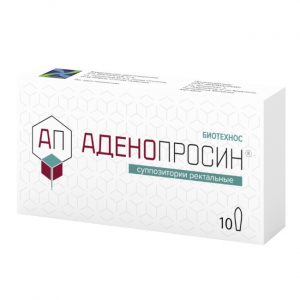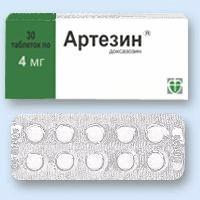Description
Release form
Tablets, 300 mg. 10 tablets in blisters or 30 tablets. in a can of lightproof glass. Each jar or 3 blisters is placed in a pack of cardboard.
Pharmacological action
Means that interfere with the synthesis of uric acid. It is a structural analogue of hypoxanthine. It inhibits the xanthine oxidase enzyme, which is involved in the conversion of hypoxanthine to xanthine and xanthine to uric acid. This leads to a decrease in the concentration of uric acid and its salts in body fluids and urine, which helps to dissolve existing urate deposits and prevents their formation in tissues and kidneys. When taking allopurinol, urinary excretion of hypoxanthine and xanthine increases.
Pharmacokinetics
After oral administration, it is almost completely (90%) absorbed from the digestive tract. It is metabolized with the formation of alloxanthin, which retains the ability to inhibit xanthine oxidase for a sufficiently long time. Cmax of allopurinol in blood plasma is reached on average after 1.5 hours, alloxanthin – after 4.5 hours after a single dose.
T1 / 2 of allopurinol is 1-2 hours, alloxanthin is about 15 hours. About 20% of the dose taken is excreted through the intestines, the rest by the kidneys.
Indications
Treatment and prevention of gout and hyperuricemia of various origins (including in combination with nephrolithiasis, renal failure, urate nephropathy). Recurrent mixed oxalate-calcium kidney stones in the presence of hyperuricosuria. Increased urate formation due to enzymatic disorders. Prevention of acute nephropathy with cytostatic and radiation therapy of tumors and leukemia, as well as with complete therapeutic fasting.
Contraindications
Severe impaired liver and / or kidney function, pregnancy, lactation, hypersensitivity to allopurinol.
Pregnancy and lactation
Contraindicated in pregnancy and lactation (breastfeeding).
Special instructions
Caution is advised to use allopurinol for impaired liver and / or kidney function (in both cases, a dose reduction is necessary), hypothyroidism. In the initial period of the course of therapy with allopurinol, a systematic assessment of liver function indicators is necessary.
During the treatment with allopurinol, the daily amount of fluid consumed should be at least 2 liters (under the control of diuresis).
An exacerbation of the disease may occur at the beginning of a course of treatment for gout. For prevention, you can use NSAIDs or colchicine (0.5 mg 3 each). It should be borne in mind that with adequate treatment with allopurinol, dissolution of large urate stones in the renal pelvis and their subsequent entry into the ureter is possible.
Asymptomatic hyperuricemia is not an indication for the use of allopurinol.
In children, it is used only for malignant neoplasms (especially leukemia), as well as for some enzymatic disorders (Lesch-Nyhen syndrome).
To correct hyperuricemia in patients with tumor diseases, allopurinol is recommended before treatment with cytostatics. In such cases, the minimum effective dose should be used. In addition, in order to reduce the risk of xanthine deposition in the urinary tract, measures must be taken to maintain optimal urine output and alkalization. With the simultaneous use of allopurinol and cytostatics, more frequent monitoring of the peripheral blood picture is necessary.
Alcohol is not allowed during allopurinol.
Influence on the ability to drive vehicles and control mechanisms: Use with caution in patients whose activities require a high concentration of attention and quick psychomotor reactions.
Composition
Tablets are white or almost white in color, round, flat-cylindrical, chamfered and notched.
1 tab. contains allopurinol 300 mg
Excipients: lactose monohydrate (milk sugar) – 49 mg, microcrystalline cellulose – 20 mg, sodium carboxymethyl starch (primogel) – 20 mg, edible gelatin – 5 mg, magnesium stearate – 4 mg, colloidal silicon dioxide (aerosil ) – 2 mg.
Dosage and Administration
Inside.
The drug should be taken 1 time per day after meals with a large amount of water. If the daily dose exceeds 300 mg or symptoms of intolerance from the gastrointestinal tract are observed, then the dose should be divided into several doses.
For initial therapy, allopurinol should be used in other dosages (100 mg) once a day. If this dose is not enough to properly reduce the concentration of uric acid in the blood serum, then the daily dose of the drug can be gradually increased until the desired effect is achieved. Special care should be taken in case of impaired renal function.
With an increase in the dose of allopurinol every 1-3 weeks, it is necessary to determine the concentration of uric acid in the blood serum.
Adults. The recommended dose of the drug is 300600 mg / day for moderate to 600900 mg / day for severe. The maximum daily dose is 900 mg.
Children. The recommended dose for children from 3 to 10 years is 5-10 mg / kg / day for 10 to 15 years – 10-20 mg / kg / day. The daily dose of the drug should not exceed 400 mg.
Allopurinol is rarely used for pediatric therapy. The exception is malignant oncological diseases (especially leukemia) and some enzymatic disorders (for example, Lesch-Nyhen syndrome).
Since allopurinol and its metabolites are excreted by the kidneys, impaired renal function can delay the drug and its metabolites in the body, followed by an extension of T1 / 2 of these compounds from blood plasma. Allopurinol and its derivatives are removed from the body by hemodialysis. If hemodialysis sessions are carried out 2-3 times a week, it is advisable to determine the need for switching to an alternative therapy regimen – taking 300-400 mg of allopurinol immediately after completion of the hemodialysis session (the drug is not taken between hemodialysis sessions).
To adjust the dose of the drug, it is necessary to evaluate the concentration of uric acid salts in the blood serum, as well as the concentration of uric acid and urate in the urine at optimal intervals.
Side effects
From the cardiovascular system: in isolated cases – arterial hypertension, bradycardia.
From the digestive system: possible dyspeptic symptoms (including nausea, vomiting), diarrhea, a transient increase in the activity of transaminases in the blood serum rarely – hepatitis in isolated cases – stomatitis, impaired liver function (transient increase in the activity of transaminases and alkaline phosphatase), steatorrhea.
From the side of the central nervous system and peripheral nervous system: in isolated cases – weakness, increased fatigue, headache, dizziness, ataxia, drowsiness, depression, coma, paresis, paresthesia, convulsions, neuropathy, visual impairment, cataracts, changes in the optic papilla, disorders taste sensations.
From the hemopoietic system: in some cases – thrombocytopenia, agranulocytosis and aplastic anemia, leukopenia (most likely in patients with impaired renal function).
From the urinary system: rarely – interstitial nephritis in isolated cases – edema, uremia, hematuria.
From the endocrine system: in isolated cases – infertility, impotence, gynecomastia, diabetes mellitus.
From the side of metabolism: in isolated cases – hyperlipidemia.
Allergic reactions: skin rash, hyperemia, itching in some cases – angioimmunoblastic lymphadenopathy, arthralgia, fever, eosinophilia, fever, Stevens-Johnson syndrome, Lyell’s syndrome.
Dermatological reactions: in isolated cases – furunculosis, alopecia, hair bleaching.
Drug interaction
With the simultaneous use of allopurinol enhances the effects of coumarin anticoagulants, adenine arabinoside, as well as hypoglycemic drugs (especially for impaired renal function).
Uricosuric agents and salicylates in high doses reduce the activity of allopurinol.
With the simultaneous use of allopurinol and cytostatics, a myelotoxic effect is more often manifested than with separate use.
With the simultaneous use of allopurinol and azathioprine or mercaptopurine, cumulation of the latter in the body is observed, because due to the inhibition of xanthine oxidase activity by allopurinol for the biotransformation of drugs, their metabolism and elimination are slowed down.
Storage conditions
In the dark place at a temperature of no higher than 30 ° C. Keep out of the reach of children.
Expiration
3 years. Do not use after the expiry date stated on the packaging.
Deystvuyuschee substances
Allopurinol
Form of Treatment
tablets
Appointment by
Children by doctor’s appointment, Adults physician education, Children over 14 years old
Indications
gout, urolithiasis




